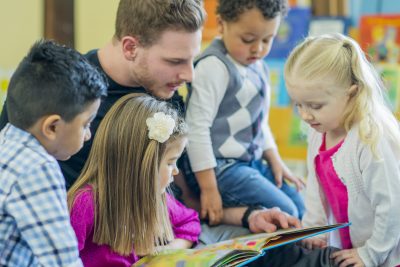Editor’s Note: Shannon Kelley, Neag School doctoral candidate in the Department of Curriculum and Instruction, prepared the following rapid research brief — in affiliation with the Center for Education Policy Analysis, Research, and Evaluation (CEPARE).

Learning to read is critical to children’s success in school and opportunities once they reach adulthood. The foundation of reading is laid in the preschool years. The ultimate goal of reading development is successful reading comprehension, which is the ability to process and interpret the written language. To comprehend a text, a reader must be able to simultaneously decode the words and apply their background knowledge to make meaning (Hoover & Gough, 1986). Although this task appears to be natural for fluent readers, it is in fact not. The ability to read is a human technology that develops over time through instruction and purposeful activities (Seidenberg, 2017).
Children’s literacy foundations are established as early as infancy and grow throughout early childhood when the brain is at its greatest plasticity levels (Hutton et al., 2020). The development of oral language skills, understanding of the alphabetic principle, and knowledge of print concepts are the greatest predictors of children’s future reading ability (e.g. Burns et al., 1999; Snow, 2006; Strickland et al., 2004). Young children who experience rich language environments have greater oral language skills (e.g. vocabulary knowledge & listening comprehension) and phonemic awareness (Kuhl, 2011; Strickland et al., 2004). Parents and guardians can support children’s development of oral vocabulary and print awareness through organic conversations and shared reading activities while a strong preschool literacy program provides instruction in more specific knowledge like the alphabetic principle and concepts of print (Burns et al., 1999; Snow, 2006). Children’s attendance at a preschool with a strong literacy program is highly correlated with reduced special education placements and retention in later elementary school and is especially impactful for children who grow up in poverty (Meloy et al., 2019; Yoshikawa et al., 2013).
Children who have abundant opportunities to interact with language from infancy to early elementary school are more likely to develop into skilled and fluent readers.
In this policy brief, I present a brief overview of early childhood literacy including its importance for future literacy achievement. I then detail six best practices for preschools of all types[1], discuss the importance of family literacy, and offer three high-leverage strategies parents and guardians can use with their children. Finally, I offer a review of best practices to support literacy development in the preschool to kindergarten transition. I conclude with a brief set of recommendations for bringing high-quality literacy practices to preschools and families in schools serving large numbers of low-income children and English language learners.
What is early childhood literacy?
Preschool literacy instruction is focused on the development of children’s emergent literacy which includes the knowledge, skills, and attitudes that ultimately promote reading and writing development (Whitehurst & Lonigan, 1998). Although children will develop many literacy skills during this time, research indicates that the following are most important (National Reading Panel, 2000; Neuman & Dickinson, 2001; Snow, 2006):
- Oral language: includes expressive and receptive vocabulary & listening comprehension skills
- Alphabetic principle: includes knowledge of the alphabet & phonological awareness (the ability to recognize and manipulate sounds in words)
- Print awareness: includes understanding and recognition of environmental print and text features
Why is children’s literacy in early childhood critical?
 Nearly 90% of a child’s neural pathways, or brain connections, are established by the time they are six-years old (Morin, n.d.). Children who have abundant opportunities to interact with language from infancy to early elementary school are more likely to develop into skilled and fluent readers because these experiences allow them to develop the many neural pathways necessary for developing literacy skills. These include the understanding that language is used for communication, letters are represented by sounds, and print conveys a message. Because children’s brains grow so rapidly during this time, both families and schools are critical to the development of children’s foundational reading skills through shared conversations, book reading, and language games. These early experiences establish a base of vocabulary, print, and content knowledge that children to build on when they enter kindergarten. Investing in early childhood literacy ensures that children have frequent and meaningful language interactions in early childhood, making them less likely to experience later reading and academic difficulty including special education placements and grade level retention.
Nearly 90% of a child’s neural pathways, or brain connections, are established by the time they are six-years old (Morin, n.d.). Children who have abundant opportunities to interact with language from infancy to early elementary school are more likely to develop into skilled and fluent readers because these experiences allow them to develop the many neural pathways necessary for developing literacy skills. These include the understanding that language is used for communication, letters are represented by sounds, and print conveys a message. Because children’s brains grow so rapidly during this time, both families and schools are critical to the development of children’s foundational reading skills through shared conversations, book reading, and language games. These early experiences establish a base of vocabulary, print, and content knowledge that children to build on when they enter kindergarten. Investing in early childhood literacy ensures that children have frequent and meaningful language interactions in early childhood, making them less likely to experience later reading and academic difficulty including special education placements and grade level retention.
Students’ experiences both at home and school play critical roles in their literacy development. Evidence suggests children learn most of their language and vocabulary related knowledge at home through caregiver and sibling interactions while they learn code related knowledge like phonemic awareness at school (Horowitz‐Kraus & Hutton, 2015). Literacy instruction in both of these spaces can be both spontaneous and planned, individual and community-based (Snow, 2006). Literacy skills and knowledge are not something that exist exclusively in a classroom; rather, they can be taught and learned in all aspects of a preschoolers’ life. For example, while a preschool teacher leads a small group in a planned rhyming activity to promote phonemic awareness, a parent or guardian might ask a four-year old to identify all the signs that have writing on them as they complete an errand around town to promote print awareness. Given all that children must learn to ultimately become readers, it is important to emphasize that there is no hierarchy in emergent literacy development – children’s understanding that the pictures in the book are connected to the written text matter just as much as children’s knowledge of the alphabet.
Evidence suggests children learn most of their language and vocabulary related knowledge at home through caregiver and sibling interactions while they learn code related knowledge like phonemic awareness at school.
Children will develop emergent literacy skills at varying rates according to their home language environment, preschool instruction, and personal development. Although there is no “typical” development path, there are a set of skills and knowledge teachers and caregivers can use to determine where a student is on the developmental continuum (see Table 1).
| 3-Year-Old (PK-3) | 4-Year-Old (PK-4) | 5-Year-Old (K) |
|---|---|---|
|
Knows how to hold books upright and turn pages
|
Recites alphabet
|
Recognizes text features including titles and authors
|
|
Listens when read to
|
Recognizes many letters
|
Names and writes most letters
|
|
Understands most pictures in books
|
Makes connections between stories and life
|
Recognizes and spells simple words
|
|
Distinguishes print from pictures
|
Produces rhymes or alliterations
|
Engages with stories through questioning and connections
|
|
Recognizes some letters
|
Pretend writes or draws to communicate ideas
|
Uses invented spelling to communicate ideas in writing
|
Note: Adapted from Snow (2006).
Understanding where students fall along a developmental continuum allows teachers and caregivers to provide intervention where necessary. Children who fall behind in their literacy development are at greater risk of not becoming fluent readers because of the Matthew effect, or the phenomena in which children with early reading difficulty have less exposure to texts because they read less, ultimately slowing their language and reading development (Stanovich et al., 1986). Children will experience reading challenges for any number of reasons, but reading difficulty is most often highly correlated with poverty, intellectual disability, hearing problems, dyslexia, ELL, and language disorders (Snow, 2006). Although these may be risk factors in children’s reading development, a strong preschool literacy program and partnerships with families can mitigate the effects on children’s reading development. In the next sections, I offer a review of the literature on best practices for preschool instruction and strategies families can use at home.
What are instructional best practices in preschool?
A majority of children ages 3-6 spend their weekdays in the care of someone other than their primary caregivers (Green et al., 2006). These arrangements include public and private preschools and home-based daycares. Preschool literacy instruction most often focuses on group activities like read aloud and alphabet instruction. In a survey of 180 preschool teachers, Green et al. (2006) found that 78% of preschool teachers read aloud to kids in groups and 93% taught the alphabet while 58% taught features of books and 63% taught about how words are arranged. The impact of preschool programming on a child’s reading development depends on teacher training, parental involvement, and length of program enrollment. In addition, researchers have found that preschool literacy instruction was more effective when teachers had a wide variety of print materials and, in one study, more children present in the classroom (Green et al., 2006; Neuman & Roskos, 1997).
Strong preschool literacy programs focus on developing children’s oral language skills, knowledge of the alphabetic code, and print knowledge. Teachers’ direct instruction can be both code and meaning-focused so students learn letters and sounds while also engaging with the meaning of words and stories (Piasta, 2016). Teachers can develop print rich environments by labeling parts of the classroom, making a variety of texts available, and cultivating many opportunities for children to talk. Research suggests that phonemic awareness and letter knowledge instruction is best supported by lessons that are brief (10 -15 minutes max), highly engaging and fun, and follow a predictable pattern (e.g. begin with rhyming followed by phonemic awareness games that have them identify/add/delete/substitute sounds, and finish with learning a new letter and sound). Class conversations and shared book reading can be more free-flowing, allowing children to engage in authentic engagements (Piasta, 2016).
Evidence indicates that teachers should actively encourage students to develop strong oral language skills and knowledge in their first language; this base affirms the children’s home language identity and serves as a foundation for the students to build on as they learn to speak and read in English.
It is important that preschool teachers keep in mind the variety of learners in their classrooms including being thoughtful about incorporating strategies to meet the needs of students for whom English is not a first language. Evidence indicates that teachers should actively encourage students to develop strong oral language skills and knowledge in their first language; this base affirms the children’s home language identity and serves as a foundation for the students to build on as they learn to speak and read in English. Researchers have found positive effects for instruction in phonemic awareness, print knowledge, and vocabulary for students who do not yet have English oral proficiency (Roberts et al., 2004). If the students’ first language shares an orthography with English (i.e. Spanish, Portuguese), print knowledge is highly transferable and can be instructed in either language (Farver et al., 2009). In addition, children who are English Language Learners benefit from explicit instruction in phonemic awareness and vocabulary in English and in frequent opportunities for adult-child conversation with feedback.
The following practices have been identified as having the greatest impact on student literacy outcomes (see Appendix A for links to additional resources).
Literacy rich environments.
A literacy rich preschool classroom promotes students’ ongoing engagement with language throughout their school day, which promotes understanding of environmental/every day print (e.g. food labels, street signs, clothing logos, etc.) and allows for independent reading activities. Literacy rich classrooms include:
- A library nook with a recommended 5 books per child with illustrations that are about everyday experiences, favorite topics, or skill foci (e.g. ABCs, rhyming) that take about 10-15 minutes to read with children (Neumann & Roskos, 1997).
- Labeled classroom parts (e.g. sink, table, etc.) which provide multiple opportunities for letter and word recognition and an understanding of how print is related to the environment.
- Play areas that incorporate literacy-related materials (e.g. cookbooks, maps, notebooks) that allow children to develop an understanding of how literacy is central to everyday life.
Interactive read aloud.
Interactive read aloud, also called dialogic or shared reading, is consistently ranked as the most impactful activity on preschoolers’ literacy development both at home and at school (Dennis & Horn, 2011). This form of reading allows children to actively engage with both code and meaning levels of the text which helps them develop understandings of the concepts of print (i.e. book features like titles, dialogue, etc.) and practice listening comprehension. An interactive read aloud should position the children as active participants in the story and should be a dynamic conversation between the adult and children about the text and connections the children have (see Table 2 for a guide).
| Prompt | Example | Accommodation |
|---|---|---|
| Completion — Completing a sentence with familiar word(s) | “Brown Bear Brown Bear, What do you see?” (Martin, 1967) “Brown bear brown bear ______?” “Purple cat purple cat _______?” (Complete with the words “what do you see?”) |
Provide the child with a picture or real object to use in place of having to speak the words. Prompt the child with the first word or words and have them complete the rest. |
| Recall — Remembering some aspect of the story (e.g., words, pictures, character, plot) | “The Very Hungry Caterpillar” (Carle, 1969) “Can you remember some of the foods that the caterpillar ate?” “What did he turn into at the end of the story?” |
Provide a child with their own copy of the book so they can more easily keep track of the sequence of the story. Reread the story individually or in small groups to assist with comprehension and recall. |
| Open ended — Requires more than just a one- or two-word response | “I Was So Mad” (Mayer, 2000) “What was your favorite part of the book?” “How could the story have ended differently?” |
Script out the first part of the response (“My favorite part was …”) and have the child complete it. Have the child choose between two different scenarios provided by the teacher in place of coming up with it all on their own. |
| Wh prompts — Who, what, when, where, why | “Rosie’s Walk” (Hutchins, 1971) “Who was Rosie trying to get away from?” “Why do you think she was trying to get away from the fox?” “Where were some of the places that she walked?” |
Preread the story to familiarize a child with the content. Allow the child to use a pointer, wooden spoon, feather, flyswatter, or other pointing device to indicate their answer. |
| Distancing — Connecting the story with children’s background knowledge | “The Little Red Hen” (Byron, 1994) “Has anyone ever made bread before?” “Have you ever needed help with something before and no one would help you?” |
Talk with families about any previous experiences with the content of the book. Allow extra time for the child to think and respond. |
Note: Table taken from Dennis & Horn (2011).
Print referencing.
Print referencing is a strategy that can be incorporated during any literacy activity but is most often used during interactive read aloud to point out important and interesting ideas about print to bring to students’ attention. Teachers can use this strategy to highlight the relationships between letters and sounds, to teach students new concepts of print, and to instruct new vocabulary. Justice & Ezell (2004) suggest the following three print referencing techniques:
- Ask questions about the print (e.g. What do you notice about the word red on this page?).
- Offer comments about print (e.g. I see the date on the newspaper the man is reading).
- Track your finger under print while you read.
Interactive conversations.
Oral language skills are highly correlated to future reading ability (Neuman & Dickinson, 2001). Teachers can actively incorporate dynamic conversation opportunities into circle times, shared reading, meals, play, and other classroom activities. These conversations give children models of speech, teach them new vocabulary words, and offer them the opportunity to practice their own speech. The following talk strategies have empirical evidence suggesting additional benefits for students (Piasta, 2016):
- Recasting: Restating what the child said with more detail or correct language (e.g. child says, “Milk” and the teacher responds, “I want milk please!”
- Expanding: Adding details to the child’s statement (e.g. child says, “Baby cry” and the teacher responds, “The baby is hurt so she’s crying”)
- Open-ended questions: Asking the child to expand their statement (e.g. child says, “I’m sad” and teacher responds, “Why are you sad?”)
- Extended reciprocal and responsive conversations: Engaging in multiple extended questions and responses with children
Small group instruction.
Preschoolers can learn many literacy skills through play and reading, but some skills and knowledge require explicit instruction from a classroom teacher. Given preschoolers’ attention spans and varying development patterns, it is wise to instruct in small groups (Piasta, 2016). This allows teachers to pay close attention to students’ individual needs and to adapt instruction as needed. The following are skills/knowledge to teach in small groups:
- Alphabet knowledge: Directly instruct letter names and sounds together and use memory aides.
- Phonological awareness: Pair with alphabet instruction and build in phoneme manipulation tasks like identifying, blending, and segmenting.
- Vocabulary: Directly instruct new words, allow for multiple interactions with the words, provide opportunities for students to use them, and post the words in the classroom. Teachers can also instruct vocabulary through book reading by introducing three new words, describing them using student friendly language, relating them to topics kids already know, and making them “come alive” through pictures or movements during book reading (Wasik, 2010).
- Writing: Provide many different opportunities for children to engage in written expression; this may include: letters, stories, picture captions, etc. Allow students to use invented spelling or attempt to represent words in print on their own. One study illustrated that students who often used invented spelling had better literacy skills because it allows them to reinforce their understanding of the relationships between letters and sounds (Ouellette & Senechal, 2008). This is most appropriate for older preschoolers who have learned at least a handful of letters though younger students should be encouraged to draw and write as well.
Assessment.
Preschool teachers can use both formal and informal literacy assessment to get an idea of students’ literacy progressions and where they are in relation to their peers. Because literacy development is so variable at this stage, teachers should use assessment data to understand how to better support students rather than as a strict categorization of their literacy abilities (Lonigan et al., 2011). Research indicates that students are most successful in literacy development if they develop knowledge and understanding of the alphabetic code, oral language skills, and print awareness in preschool, so assessments should be focused on students’ letter and vocabulary knowledge, phonological awareness, and print concepts (Snow, 2006).
There are three primary forms of assessment for preschool literacy: screeners, diagnostics, and progress monitoring tools. Screeners are often brief measures used on all students to determine which students are at risk of delayed literacy development. Diagnostics are longer assessments used to identify specific domains in which students need more support; these are expensive and long tests which should be reserved for students with low screener scores. Progress monitoring tools allow teachers to track students’ academic progress over time; standardized measures of this type for all students are less widely available for preschool literacy. Currently, the field of special education offers a handful of tests based on a General Outcome Measurement Approach, which measures student growth over many points in time (Greenwood et al., 2011), to help early childhood educators determine when a student might need an intervention (see Appendix A for links to assessment resources).
What can families do to support literacy development at home?
Children develop almost all of their neural connections for sensory pathways and language during their first six years of life (Nelson, 2000). For this reason, preschoolers’ experiences both at school and at home are critical to successful literacy development. In one study, researchers found a significant relationship between children’s vocabulary knowledge and expressive language and the amount of time children spent engaged in book reading with their mothers (Roberts et al., 2005). The home literacy environment promotes multiple opportunities for language learning which are necessary for neural connections development through factors like the amount of shared adult-child reading, the number of books in the house, and children’s interaction with print (Horowitz‐Kraus & Hutton, 2015).
Fortunately, best practices for family literacy support require few resources and can be built into existing family routines. Researchers have consistently identified shared book reading as the most impactful activity families can do to support preschool literacy development as it promotes vocabulary development, understanding of text features, and print awareness (Whitehurst & Lonigan, 1998). In addition, authentic and frequent open-ended conversations with adults in the home support children in enhancing their receptive and expressive vocabularies. A strong oral vocabulary is a critical foundation for reading development as it allows children to both understand the content of texts and identify words as they learn to decode in early elementary school.

The following family practices have been identified as having the greatest impacts of students’ literacy development (see Appendix B for links to additional resources).
Shared reading.
Language benefits from shared reading have been shown to begin with children as young as six-weeks old (Burns et al., 1999). Children who read with their families at home and who make regular visits to the local library demonstrate stronger vocabulary skills (Senechal et al., 1996). When caregivers read with their children, they can use the following strategies to make the activity engaging and to emphasize critical language and vocabulary skills (Roberts et al., 2005):
- Simple description: Describe a character, animal, object, simple action, or location; “Look at the zebra- I see he has white and black stripes. What else do you notice?”
- Elaborate description: Explain, summarize, or elaborate on plot; “George is really curious so he asks lots of questions and explores the world.”
- Links to world: Ask questions or make comments that help the child make connections between the text and their experiences; “Who else do you know that is very curious?”
- Predictions and inferences: Ask child to predict what might happen or ask questions about character motivations/feelings; “Why do you think George was sad after he lost his boat?”
- Book concepts: Refer to parts of the book or book reading process (e.g. turning the page, pointing out the title, etc.)
- Letter-sound relationships: Point out letter-sound information; “This word is Cat begins with a “c” which makes the sound /k/.”
- Recall and recite: Ask child to tell you about the text; “Oh that was a great story, can you tell me about it?”
Open-ended conversation.
Children’s exposure to the world outside of school and home allows them to develop rich background and vocabulary knowledge which further strengthens the synapses needed for reading development. Parents and guardians can use these experiences to facilitate rich open-ended conversations with children by asking open-ended questions that allow children to explain their ideas and understandings. Although adventures outside of the home are a great time to engage in these conversations, these same techniques can be applied to everyday tasks around the home like eating meals together and getting dressed for school. In addition, these are great opportunities to introduce and explain new vocabulary (Strickland et al., 2004). Here are some tips for facilitating strong conversations:
- Get on the child’s level (if possible)
- Actively listen and respond to what the child says
- Take turns talking
- Ask questions about what the child is doing, seeing, or talking about
- Give time for the child to respond
- Extend children’s language (e.g. if the child says “car”, you can say “yes a red car is parked”)
- Ask children to explain their thinking by using “why” and “how” questions Develop a standardized format to communicate with kindergarten teachers. Preschools and kindergartens use a range of assessment and data tracking methods however both have copious information about students’ literacy development. To streamline the coordination of record sharing and teacher communication, preschools can create a standardized format to capture literacy-related information, prioritizing data on children’s vocabulary, alphabet knowledge, and print awareness.
Language games.
Children’s phonemic awareness is strengthened by their interactions and understanding of language. Families can support this understanding by leading children in games that help them pay attention to the different sounds and relationships in letters and words. These activities can be spontaneous, brief, fun, and as simple as singing a song together. Ideas include:
- “I spy” or Treasure Hunts: Lead children to identify an object around them by saying, “I spy something that starts with the letter a” or “Find me something in the room that starts with the letter ” These tasks require students to link the name of the letter (a) with its sound in the word which reinforces phonemic awareness and understanding of letter-sound correspondences (Games for 3-year-olds).
- Rhyming: Lead children in a game of rhyme generation by saying, “I know a word that rhymes with cat, it’s rat. Your turn, tell me a word that rhymes with rat.” Rhyming is a foundational skill of phonemic awareness as it requires students to pay attention to the middle and end sounds of the word. This attention supports their ability to segment unknown words, which is a critical skill for early decoding (Palmer, I. M.).
- Sing nursery rhymes & other songs: Nursery rhymes and other classic early childhood songs promote language development through the inclusion of repetition, rhyming, and alliteration (Paquette & Rieg, 2008). Singing helps children develop new vocabulary knowledge and promotes joy in the language learning experience (see ideas of songs).
Supporting literacy in the preschool to kindergarten transition
School and home-based preschool experiences allow children to develop the foundational literacy skills they need to build on throughout early elementary school as they learn to read. By the end of kindergarten, children are expected to recognize and write the letters of the alphabet, demonstrate phonemic awareness by generating rhymes and isolating, blending, and segmenting phonemes in words, and have a solid understanding of the structures of books and other print materials (Burns et al. 1999). The transition from preschool to kindergarten requires students to take on more independence, follow routines, and engage in more challenging academic work. For this reason, it can be a challenging transition for some children. Additionally, preschools and kindergartens are often separated by physical distance and system administration; that is, many children attend private or home-based preschools prior to entering the public school system (Purtell et al., 2020). Despite these differences, there is much that both preschools and families can do to set children up for success during this transition (see Appendix C for links to additional resources.
Preschools
- Literacy program: The most important thing preschools (including public, private, and home-based programs) can do is establish strong literacy programming. This includes creating literacy rich environments with many accessible books, leading daily interactive story times, and building in many opportunities for adult-child and child-child conversations (Burns et al., 1999).
- Family partnerships: Programs can actively work with families to create shared literacy models by incorporating reading and its importance into daily activities. To do this, programs can invite families to story time, send books home regularly, partner with local libraries for family visits and book sharing, provide families with a clear model of dialogic reading and print referencing (this can include handouts and video links), and host family literacy nights where children, caregivers, and teachers engage in book reading and language games (Dennis & Horn, 2011).
- Communication with kindergartens: Because many children do not attend public preschool, there is often a gap in communication from preschool to kindergarten. Preschool teachers can minimize this gap by actively communicating with local kindergarten programs about students’ experiences and academic needs. School districts can strengthen this partnership by bringing preschools and kindergartens together to align programming and information structures and by issuing surveys of local preschools to gather information about children’s experiences including type of school, length of program, and attendance history (Purtell et al., 2020).
- Partner with non-English speaking families: Evidence from a 2008 study (Roberts) suggests that shared reading in students’ primary language is just as effective as in English, especially if the same story is read at home and at school. Because research illustrates that students primarily learn oral language skills like vocabulary and expression at home, students benefit from partnerships that encourage shared reading and other language games in their primary language. Schools can partner with non-English speaking families by providing them with reading material and suggested practices in their primary language and by actively encouraging word play and engaging conversations with their children (Restrepo & Towle-Harmon, 2008).
Families
- Kindergarten transition days: One of the most important things families can do to support the preschool to kindergarten transition is attend the transition days or experiences that the schools offer. This allows children to meet their teachers and classmates and the parents/guardians to develop a positive relationship with the teachers.
- Bridge preschool-kindergarten communication: Before children exit preschool, parents/guardians can ask the preschool teachers about their child’s literacy skills. Parents can share this information with the kindergarten teacher; having an initial understanding of students’ oral language, alphabet knowledge, and print awareness allows the kindergarten teacher to act quickly to deliver responsive intervention for students who may need it.
- Home literacy practices: When children begin kindergarten, families should continue nightly shared reading and regular library visits. It is important for children to view literacy experiences as enjoyable and motivating, especially as they begin to read as the process can be challenging for many children. Allowing children to choose books to read and using those books as time for engaging dialogue and sharing keeps these experiences meaningful and light for children.
Recommendations
The evidence on the benefits of early literacy development is clear – children who have strong oral language skills, alphabet knowledge, and beginning print awareness are more likely to become proficient readers in early elementary school (National Reading Panel, 2000). Fortunately, there are many promising practices that school districts, private, public and home-based preschools, and families can implement to support preschoolers’ literacy development. I outline recommendations below.
School District
- Provide ongoing teacher training. A range of training exists for preschool teachers including professional developments on emergent literacy practices and on implementation of specific curricula (Piasta, 2016). Teachers who receive high quality training in shared book reading practices and language development strategies are more likely to feel confident in their instruction and have greater effects on students’ literacy development (Green et al., 2006; Piasta, 2016; Wasik, 2010). Organizations like the National Association for the Education of Young Children and Reading Rockets offer a host of online resources and accessible modules.
- Create structures for public, private, and home-based preschool providers to connect with district kindergarten teachers. Because kindergarten is often most students’ first interaction with the public school system, kindergarten teachers often lack critical information about students’ previous literacy experiences (Purtell et al., 2020). The school district can mitigate this gap by providing communication structures or professional development opportunities for preschool and kindergarten teachers to share information about curriculums and student progress.
Preschools
- Host multiple family literacy opportunities. Preschool teachers are uniquely positioned to support family literacy opportunities because they interact with caregivers daily during pick up and drop off. Teachers and preschools can use these moments to emphasize the importance of reading and language development by offering book sharing programs and shared reading examples. In addition, schools can support the community-based nature of literacy by hosting family literacy nights and regular library visits to immerse children and families in fun, meaningful literacy activities.
- Develop a standardized format to communicate with kindergarten teachers. Preschools and kindergartens use a range of assessment and data tracking methods however both have copious information about students’ literacy development. To streamline the coordination of record sharing and teacher communication, preschools can create a standardized format to capture literacy-related information, prioritizing data on children’s vocabulary, alphabet knowledge, and print awareness.

Shannon Kelley is a doctoral candidate in the Department of Curriculum and Instruction at the University of Connecticut. (Stefanie Dion Jones/Neag School)
Families
- Read with children nightly. Research literature (e.g. Scarborough et al. 1991; Snow, 2006) consistently ranks family shared book reading as the most impactful literacy development activity. Families can borrow books from local libraries, from preschools, or use digital options (see Reading Rockets for links).
[1] Throughout this brief, the term preschool refers to public school, private, and home-based programs.
Author Biography
Shannon Kelley is a doctoral candidate in the Department of Curriculum and Instruction at the University of Connecticut. Shannon’s research applies lenses from neo-institutional theory to understand how middle and high schools conceptualize and organize reading programs for students with persistent reading difficulty. Shannon has also engaged in research on teacher preparation, multisyllabic word reading instruction, and dyslexia discourse. Prior to graduate school, she taught high school English and middle school special education for almost a decade. In addition to her studies, Shannon currently teaches undergraduate and master’s-level courses on literacy instructional methods and works with local districts to design and implement high school reading intervention courses.
CEPARE produces high-quality research, evaluation, and policy analysis that informs leaders and policymakers on a range of pressing issues, with a particular focus on enhancing social justice and equity across p-20 educational settings in Connecticut and beyond. CEPARE produced this brief as part of the SETER Alliance, which aims to strengthen and support learning opportunities in Connecticut’s Alliance districts. Learn more about CEPARE cepare.uconn.edu. Access the original PDF of this brief (including all references and appendices).
Related Stories:
- Grade Retention After COVID-19: Evidence-Based Guidance
- The Payoff of Preschool: Investing in CT’s Youngest Residents
- The Prevalence and Price of Police in Schools
- Reducing Racism in Schools: The Promise of Anti-Racist Policies
Some content on this website may require the use of a plug-in, such as Adobe Acrobat Viewer.



